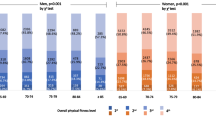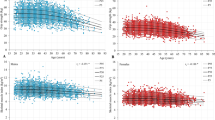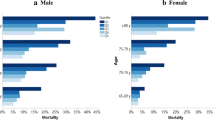Key summary points
To determine the best machine learning (ML) regression model for predicting grip strength in adults above 65 years through physical performance and body composition.
AbstractSection FindingsWalking ability and grip strength are closely related, and the Figure-of-8 walk test is a reasonable indicator of grip strength in older adults.
AbstractSection MessageThis study can be used to develop more accurate predictive models of grip strength in older adults.
Abstract
Purpose
We aimed to determine the best machine learning (ML) regression model for predicting grip strength in adults above 65 years using various independent variables, such as body composition, blood pressure, and physical performance.
Methods
The data comprised 107,290 participants, of whom 33.3% were male and 66.7% were female in Korean National Fitness Award Data from 2009 to 2019. The dependent variable was grip strength, which was calculated as the mean of right and left grip strength values.
Results
The results showed that the CatBoost Regressor had the lowest mean squared error (M \(\pm\) SE:16.659 ± 0.549) and highest R2 value (M \(\pm\) SE:0.719 ± 0.009) among the seven prediction models tested. The importance of independent variables in facilitating model learning was also determined, with the Figure-of-8 walk test being the most significant. These findings suggest that walking ability and grip strength are closely related, and the Figure-of- 8 walk test is a reasonable indicator of grip strength in older adults.
Conclusion
The findings of this study can be used to develop more accurate predictive models of grip strength in older adults.


Similar content being viewed by others
Data availability
All data generated during the current study have been included in this published article and its original dataset and coding file are available from the corresponding author (Dae Yun Seo) on reasonable request.
References
Dodds RM et al (2014) Grip strength across the life course: normative data from twelve british studies. PLoS ONE 9(12):e113637
Cheung CL et al (2013) Association of handgrip strength with chronic diseases and multimorbidity: a cross-sectional study. Age (Dordr) 35(3):929–941
Peterson MD et al (2017) Low normalized grip strength is a biomarker for cardiometabolic disease and physical disabilities among U. S. and Chinese Adults. J Gerontol A Biol Sci Med Sci 72(11):1525–1531
Kong YK et al (2019) Evaluation of subjective perceived rating for grip strength depending on handedness for various target force levels. Work 62(1):21–26
Lee SH et al (2022) Estimation of functional fitness of Korean older adults using machine learning techniques: The National Fitness Award 2015–2019. Int J Environ Res Public Health 19(15):9754
Fujita K et al (2022) Machine learning-based muscle mass estimation using gait parameters in community-dwelling older adults: a cross-sectional study. Arch Gerontol Geriatr 103:104793
Tedesco S et al (2021) Comparison of machine learning techniques for mortality prediction in a prospective cohort of older adults. Int J Environ Res Public Health 18(23):12806
Norman K et al (2011) Hand grip strength: outcome predictor and marker of nutritional status. Clin Nutr 30(2):135–142
Ali MH et al (2015) Predicting hand grip strength of hand held grass cutter workers: neural network vs regression. Procedia Manufacturing 2:445–449
Ko B-G et al (2021) Prediction equations of physical fitness age for Korean adults. Exerc Sci 30(3):352–360
Angst F et al (2010) Prediction of grip and key pinch strength in 978 healthy subjects. BMC Musculoskelet Disord 11(1):1–6
Hahn P et al. (2016) Machine learning as a tool for predicting insincere effort in power grips. bioRxiv, p. 068494
Taha Z (2005) Grip strength prediction for Malaysian industrial workers using artificial neural networks. Int J Indust Ergonom 35(9):807–816
Brach JS et al (2022) Effect of timing and coordination training on mobility and physical activity among community-dwelling older adults: a randomized Clinical trial. JAMA Netw Open 5(5):e2212921–e2212921
Lowry K et al (2022) The Figure-of-8 walk test used to detect the loss of motor skill in walking among persons with Parkinson’s disease. Physiother Theory Pract 38(4):552–560
Chou M-Y et al (2019) Role of gait speed and grip strength in predicting 10-year cognitive decline among community-dwelling older people. BMC Geriatr 19(1):186
Coyle PC et al (2020) Development and validation of person-centered cut-points for the Figure-of-8-Walk test of mobility in community-dwelling older adults. J Gerontol Series A 75(12):2404–2411
Lim J-H, Lee H-S, Song C-S (2021) Home-based rehabilitation programs on postural balance, walking, and quality of life in patients with stroke: A single-blind, randomized controlled trial. Medicine 100(35):e27154
Nualyong T, Siriphorn A (2022) Accuracy of the figure of 8 walk test with and without dual-task to predict falls in older adults. J Bodyw Mov Ther 30:69–75
Peimankar A et al (2023) A machine learning approach for walking classification in elderly people with gait disorders. Sensors 23(2):679
Kim SH et al (2022) Usefulness of hand grip strength to estimate other physical fitness parameters in older adults. Sci Rep 12(1):17496
Pérez E et al (2021) frailty level prediction in older age using hand grip strength functions over time. In Advances in Computational Intelligence. Springer International Publishing, Cham
Sajeev S et al (2022) Machine learning models for identifying pre-frailty in community dwelling older adults. BMC Geriatr 22(1):794
Acknowledgements
The authors would like to thank the anonymous subjects who agreed to participate in the study. The authors would also like to thank the Korea Sports Promotion Foundation for this study.
Funding
This work was supported by the Dong-A University research fund and the Ministry of Education of the Republic of Korea and the National Research Foundation of Korea (NRF-2021R1I1A1A01047419, NRF-2021S1A5A2A01065487).
Author information
Authors and Affiliations
Contributions
Jun-Hyun Bae & Xinxing Li contributed to the data collection, data analysis and writing of the manuscript; Jun-Hyun Bae & Xinxing Li contributed to the data collection, data analysis and writing of the manuscript; Dae Yun Seo & Sangho Lee contributed to the data collection and reviewed the manuscript; Taehun Kim & Hyun-Seok Bang contributed to the data collection and reviewed the manuscript. All authors approved the final draft of the manuscript.
Corresponding authors
Ethics declarations
Conflict of interest
The authors have no competing interests to declare that are relevant to the content of this article.
Ethics approval and consent to participate
For this type of study, formal consent is not required. The dataset was approved by Research Ethics Committee, Hyupsung University (7002320-202303-HR-001), and all methods were performed in accordance with the relevant guidelines.
informed consent
Informed consent was obtained from all individual participants included in the study.
Additional information
Publisher's Note
Springer Nature remains neutral with regard to jurisdictional claims in published maps and institutional affiliations.
Rights and permissions
Springer Nature or its licensor (e.g. a society or other partner) holds exclusive rights to this article under a publishing agreement with the author(s) or other rightsholder(s); author self-archiving of the accepted manuscript version of this article is solely governed by the terms of such publishing agreement and applicable law.
About this article
Cite this article
Bae, JH., Li, X., Kim, T. et al. Prediction models of grip strength in adults above 65 years using Korean National Physical Fitness Award Data from 2009 to 2019. Eur Geriatr Med 14, 1059–1064 (2023). https://doi.org/10.1007/s41999-023-00817-7
Received:
Accepted:
Published:
Issue Date:
DOI: https://doi.org/10.1007/s41999-023-00817-7




